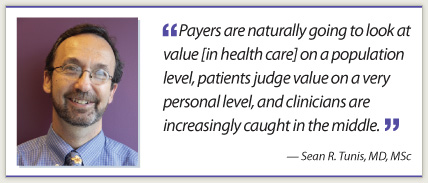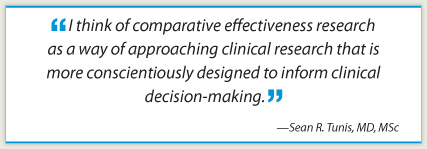With the Presidential election just around the corner, the health-care debate will undoubtedly heat up. The ASCO Post spoke with Sean R. Tunis, MD, MSc, Founder and Director, Center for Medical Technology Policy, and former Chief Medical Officer for the Centers for Medicare & Medicaid Services, about how regulatory agencies make coverage decisions, and how we might take steps to bring more value to our clinical decisions.
The Bevacizumab Issue
 Despite FDA’s decision to revoke its approval of bevacizumab (Avastin) for breast cancer, Medicare—the nation’s largest payer—continues to provide coverage for this very expensive drug. Why?
Despite FDA’s decision to revoke its approval of bevacizumab (Avastin) for breast cancer, Medicare—the nation’s largest payer—continues to provide coverage for this very expensive drug. Why?
The issue about how Medicare decides which cancer treatments to pay for is complicated by the extensive legal and regulatory history of this issue. Some of the rules guiding Medicare’s reimbursement policy in the oncology sector leave the agency with relatively limited choices in their policy regarding off-label use, which accounts for approximately 50% or more of cancer care treatments.
In the case of bevacizumab, many would think that because the agent had its breast cancer indication revoked in quite dramatic fashion, it would be a cut-and-dry coverage decision for Medicare. But because bevacizumab continues to be an FDA-approved product for some cancer indications, the breast cancer indication essentially falls into the off-label use area.
Coverage Decisions
What factors does Medicare consider for coverage decisions?
Medicare coverage decisions rely largely on the core belief that physicians will use drugs or technologies in a clinically responsible way, guided by training and current evidence, all within the regulatory realities of the day.
On the surface there might seem to be conflicts among particular coverage policies, as in the case of bevacizumab. The expectation is that whether or not Medicare pays for a drug or service, if it’s not appropriate for patient care, physicians would not use it. That’s an oversimplification, but that’s pretty much how Medicare has historically looked at coverage issues—depending heavily on providers to apply evidence-based clinical decision-making.
Moreover, Medicare looks for guidance from the recognized drug compendia, and has formal policies stating that the agency will pay for off-label uses of agents that are listed in one or more of the authorized compendia. The National Comprehensive Cancer Network’s NCCN Drugs & Biologics Compendium is a mandated reference for establishment of coverage policy and coverage decisions regarding the use of drugs and biologics in cancer care.
Since metastatic breast cancer remains listed by NCCN as an appropriate indication for bevacizumab, Medicare covers its off-label use, regardless of the recent FDA revocation.
Clinical Trials
Is there a better way to weed out agents that seem to make it through the clinical trial system, then underperform in the general population?
One thing that would help bring better drugs to the patient population is simply having more adult participation in cancer clinical trials. That’s the only way to get the data we need to make qualitative decisions. To my mind, we need to have some form of public relations campaign and educational effort that would help debunk myths about trials and reinforce the benefits of receiving new therapies in the context of trials.
By trying strategies to match the high rate of pediatric clinical trial participation, it might be possible to move to a place in which adult participation is the rule, not the exception. Substantially increasing the volume of patients with cancer participating in trials would probably ensure that the failure rate of early trials wouldn’t be as great, plus it would give us more information about what compounds truly offer benefits that exceed the risks, and for which specific patient subgroups.
Health Information Technology
Quality and value of care are at the heart of the current political health-care vernacular. An interoperable health information technology system to help foster those goals is part of the larger plan. Are we moving in the right direction?
We’re making headway in that initiative in terms of focusing on interoperability and performance standards of electronic medical records. However, that progress may not be highly visible yet within the overall structure of health care, in terms of making an impact on quality measurement, quality improvement, and clinical care.
A big part of the reason we’re not seeing broader use of health information technology for quality measurement and performance improvement is because it takes time to reach a consensus on the standards and common data elements needed for interoperability. We also need the ability to integrate common data from electronic medical record systems made by different manufacturers.
We are moving steadily forward to get information technologies in place, but we just won’t see a high level of practical impact for several years to come. After we make more progress on the technical issues of interoperability, we’ll see much more rapid advances that truly change the way our health system operates.
Comparative Effectiveness
 With the election season heating up, components of the Affordable Care Act will take center stage. One initiative that draws fire is comparative effectiveness research. Is this a viable mechanism to assess value on a large enough scale to make a difference?
With the election season heating up, components of the Affordable Care Act will take center stage. One initiative that draws fire is comparative effectiveness research. Is this a viable mechanism to assess value on a large enough scale to make a difference?
Yes, comparative effectiveness research will help to improve the value of health-care services, though only in conjunction with other major payment and delivery system reforms that are underway. I think of comparative effectiveness research as a way of approaching clinical research that is more conscientiously designed to inform clinical decision-making.
For example, clinicians and patients often try to make comparative decisions when considering treatment choices. So it’s more helpful to have head-to-head comparative data with which to make those decisions. Comparative effectiveness research also looks at studies that emphasize more quality-of-life and patient-reported functional outcomes. In terms of patient experience, that kind of information is often more helpful than, for instance, clinical endpoints focusing solely on the rate and extent of tumor growth.
As drug and device companies, as well as the NIH, start thinking more clearly about designing studies that answer the practical questions that clinicians and their patients face daily, clinical research will better inform value-based decisions. No matter how you define comparative effectiveness research, we are seeing a concerted effort to make more of our research relevant to the needs of patients, clinicians, and payers. And that combined effort will inevitably lead to more and better judgments about risks, benefits, and value.
Clinical Value
In order to achieve across-the-board value over volume, we need to harmonize the needs of clinicians, patients, and payers. Is that possible?
There are ways to reduce the apparent disparity of viewpoints among these three major decision-makers about what constitutes important evidence of clinical value in specific clinical conditions. Through simple dialogue, we find that the dispersion of viewpoints doesn’t completely harmonize, but when people actually listen to each other, common understanding begins to materialize. So we need to provide more opportunities for stakeholders to have meaningful dialogue about issues of research priorities and study design. It can’t be done effectively if there continue to be separate conversations in separate forums.
That said, payers are naturally going to look at value on a population level, patients judge value on a very personal level, and clinicians are increasingly caught in the middle. There are going to be persistent differences of opinion on what defines value in health care. But if we think in terms of specific clinical benefits such as quality of life, survival, or patient experience with side effects, there is likely to be more convergence about the meaning of clinical value. Building consensus across stakeholder groups about specific benefits through more sustained interaction is a good start.
Closing Thoughts
Any closing thoughts on bringing much-needed value to our health-care system?
We have so much work to do that relates to discovering the relative benefits and risks of how we treat disease that when we integrate costs into the equation, it becomes very difficult to have a rational discussion about value. We tend to immediately jump to arguments about cost-effectiveness thresholds and how to interpret quality-adjusted life years, forgetting that all of these things are currently based on extremely uncertain estimates of just what the risks and benefits are.
Decision-making would benefit from our spending more time and money on concrete ways to improve our knowledge of health risks and benefits, like improving our clinical trial system and advancing our health information technology capabilities. Once we have less uncertainty about these clinical effectiveness questions, we can at least have a more informed argument about the relative costs of achieving those benefits or avoiding those risks. ■
Disclosure: Dr. Tunis reported no potential conflicts of interest.

